When operating a John Deere 333G, you might not realize the array of common issues that could affect its performance. From hydraulic leaks to electrical malfunctions, these problems can hinder your productivity. But what if there are simple steps you can take to prevent or resolve these issues efficiently? Stay tuned to discover practical tips and insights to keep your John Deere 333G running smoothly and minimize downtime.
Things to Note
- Hydraulic leaks can occur; promptly address and inspect for damage.
- Overheating engine issues may arise; check coolant levels and radiator.
- Electrical malfunctions can occur; inspect wiring and prevent battery drainage.
- Regularly check and adjust track tension to prevent issues.
- Watch for transmission problems like gear slipping; address promptly.
Hydraulic Leaks
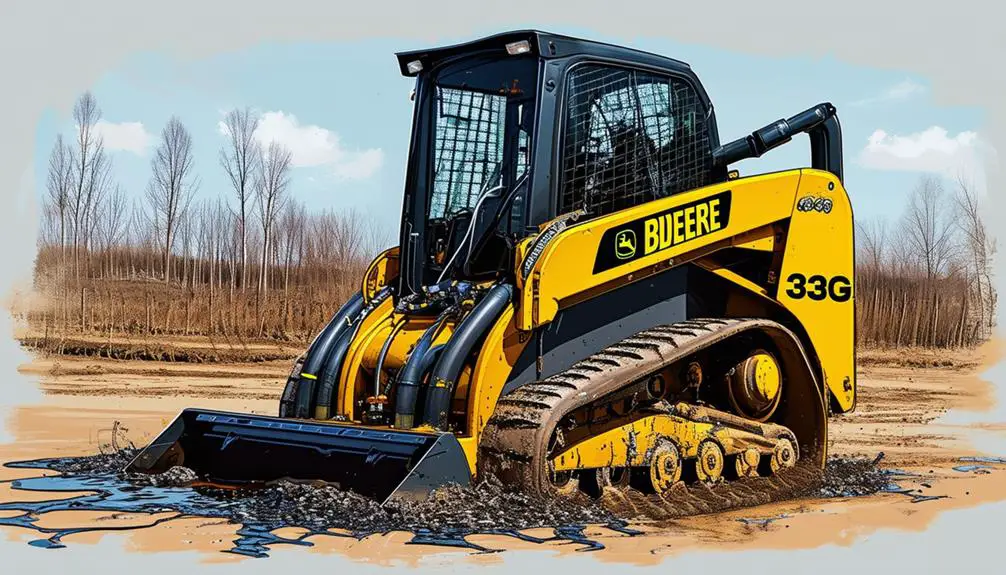
If you notice hydraulic leaks on your John Deere 333G, address them promptly to prevent damage and secure peak performance. Ignoring these leaks can lead to a decrease in efficiency and potential system failures. Liberation awaits as you take charge of this issue swiftly.
To tackle hydraulic leaks, start by locating the source. Check for damaged hoses, loose connections, or faulty seals. Once identified, replace or repair the affected parts immediately. Embrace the power to maintain your machine in top condition.
Regularly inspecting your John Deere 333G for leaks is a proactive approach to secure smooth operations. By staying vigilant, you assert your control over the situation. Embrace the freedom that comes with being proactive in maintenance.
Overheating Engine
Address an overheating engine promptly to maintain peak performance and prevent potential damage to your John Deere 333G. When your engine starts overheating, it's vital to act fast to avoid costly repairs and downtime.
The most common reasons for engine overheating in the John Deere 333G include low coolant levels, a malfunctioning thermostat, a clogged radiator, or a failing water pump.
To tackle this issue, start by checking the coolant levels and ensuring there are no leaks in the system. If the coolant levels are low, top them up with the recommended coolant for your machine.
Next, inspect the thermostat to see if it's functioning correctly and replace it if necessary. Additionally, check the radiator for any debris or blockages that might be hindering proper airflow.
Regular maintenance, such as cleaning the radiator and checking coolant levels, can prevent your engine from overheating.
Electrical Malfunctions
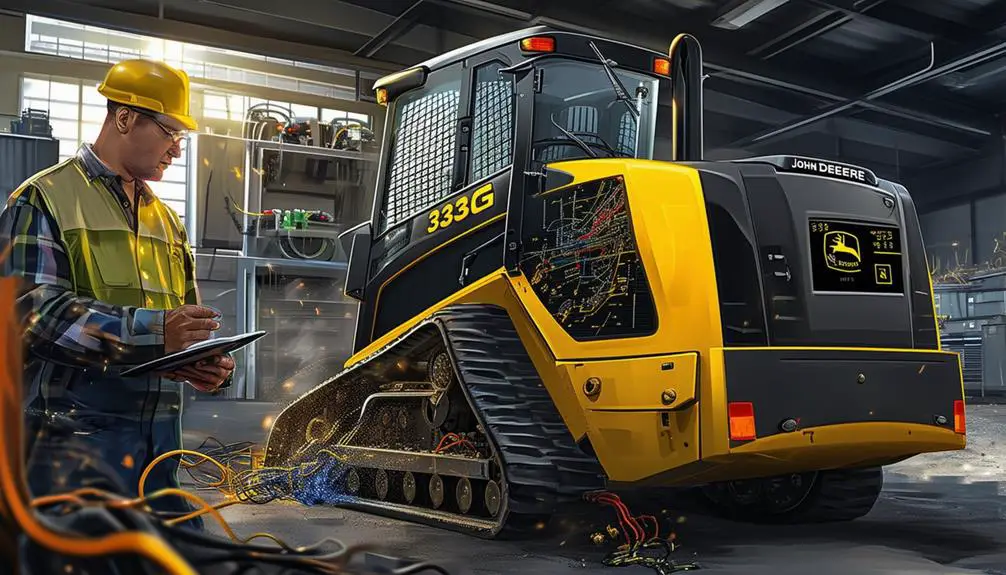
You may encounter wiring harness issues or battery drainage concerns with your John Deere 333G. These electrical malfunctions can cause unexpected downtime and impact your work productivity.
Addressing these problems promptly is crucial to keep your machine running smoothly.
Wiring Harness Issues
When experiencing wiring harness issues in your John Deere 333G, it's vital to address them promptly to prevent electrical malfunctions. Faulty wiring harnesses can lead to a range of problems, such as lights not working, engine issues, or even complete shutdowns.
To tackle this, start by visually inspecting the wiring harness for any visible damage like fraying, cuts, or exposed wires. Check that all connections are secure and free of corrosion. If you notice any issues, consider repairing or replacing the affected wiring harness to maintain peak electrical function in your 333G.
Regularly checking the wiring harness can prevent more significant problems down the line. Issues in the wiring system can be frustrating and potentially hazardous if left unattended. By staying proactive and addressing wiring harness concerns promptly, you can avoid unexpected downtime and costly repairs.
Battery Drainage Concerns
To prevent potential battery drainage concerns in your John Deere 333G, regularly inspect the electrical system for any signs of malfunction. Here are some tips to help you avoid battery drainage issues:
- Check for Corroded Terminals: Verify that the battery terminals are clean and free of corrosion, as this can cause electrical resistance and drain the battery.
- Inspect Wiring for Damage: Look for any frayed or damaged wires in the electrical system that could be causing a short circuit and draining the battery.
- Test Alternator Output: Confirm the alternator is functioning correctly and charging the battery properly to prevent drainage issues.
- Turn Off Accessories When Not in Use: Be mindful of leaving accessories like lights or the radio on when the engine is off, as this can lead to unnecessary battery drain.
Track Tension Issues
Track tension problems on your John Deere 333G can lead to performance issues and potential safety hazards. When the tracks are too loose, you might experience track slippage, reduced traction, and uneven wear on the undercarriage components.
On the other hand, overly tight tracks can put excessive strain on the drive system, leading to premature wear and tear.
To ensure peak performance and safety, it's essential to regularly check and adjust the track tension according to the manufacturer's guidelines. A simple track tension gauge can help you maintain the correct tension levels and prevent costly repairs down the line.
If you notice any signs of track tension issues such as excessive track sagging or track tightness, address them promptly to avoid further damage. By staying proactive and attentive to your machine's track tension, you can optimize its efficiency and longevity while minimizing the risk of accidents or breakdowns.
Transmission Problems
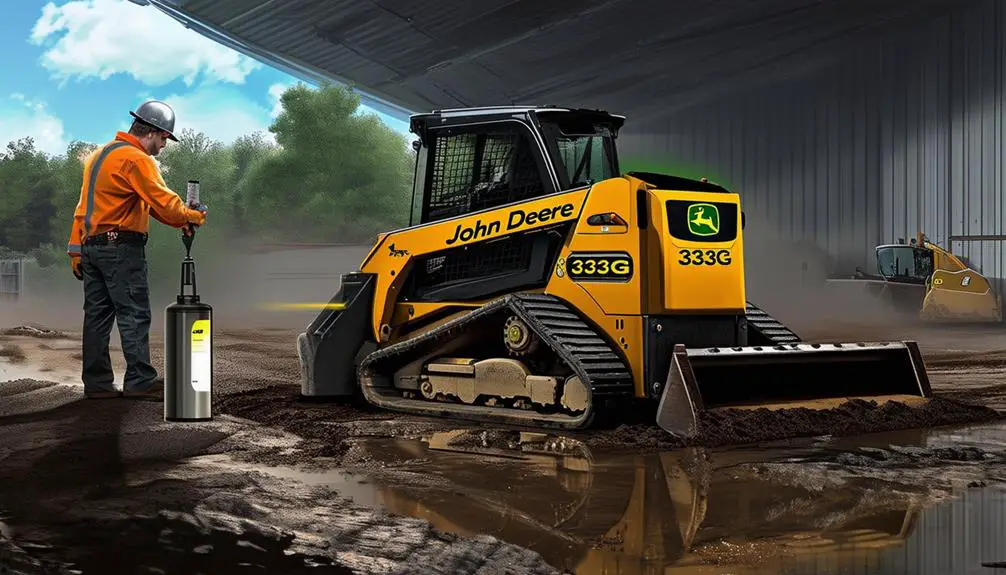
Check for any warning signs like unusual noises or difficulty shifting gears to identify potential transmission problems in your John Deere 333G. If you suspect transmission issues, here are some common problems you might encounter:
- Gear Slipping: If you experience the gears slipping or the machine unexpectedly changing gears while in operation, it could indicate a transmission problem.
- Delayed Gear Engagement: Difficulty when trying to shift gears or a delay in the transmission responding to gear changes may signal transmission issues.
- Leaking Transmission Fluid: Keep an eye out for any leaks under your machine that could be transmission fluid. Low fluid levels can lead to transmission problems.
- Burning Smell: A burnt odor coming from the transmission area is a red flag. It could indicate overheating or other internal issues that need attention.
Being proactive and addressing these signs promptly can help prevent further damage to your John Deere 333G's transmission system.
Hydraulic Pump Failures
What're the common signs of hydraulic pump failures in your John Deere 333G that you should watch out for?
When your hydraulic pump starts failing, you might notice issues like slower or unresponsive movements of the boom or bucket. If you experience a loss of power or strange noises coming from the pump area, it could be a sign of impending failure. Keep an eye out for any leaks around the hydraulic pump, as this could indicate a problem that needs immediate attention. Additionally, if you notice a decrease in overall hydraulic system performance, it might be time to investigate the health of your pump.
Hydraulic pump failures can be frustrating, but staying alert to these warning signs can help you catch issues early on.
Regular maintenance and inspections can also prevent costly repairs down the line. Remember, addressing hydraulic pump problems promptly can keep your John Deere 333G running smoothly and efficiently.
Attachment Connection Failures
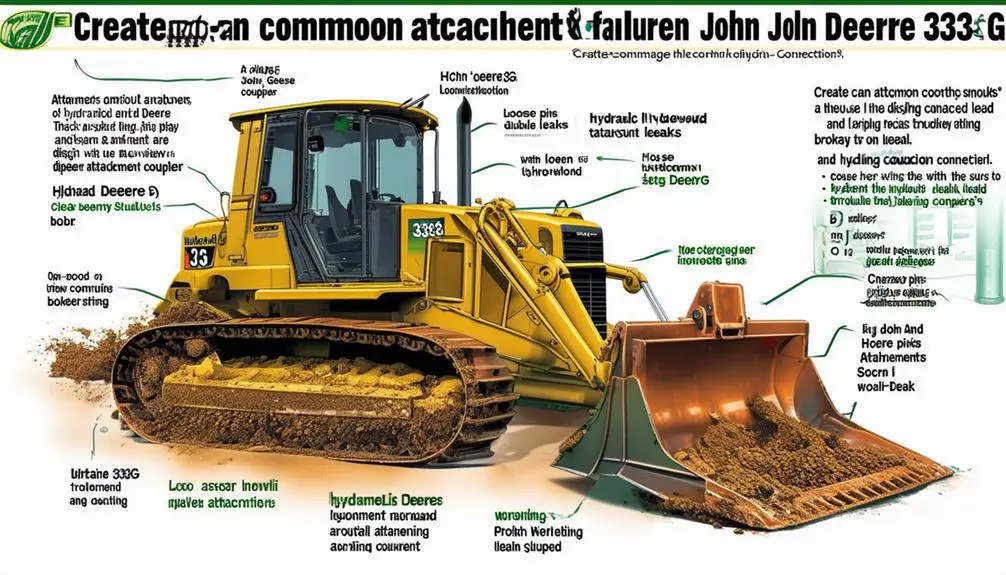
You need to be aware of potential attachment connection failures on your John Deere 333G. Troubleshooting these issues promptly can prevent costly downtime.
Implementing solutions for faulty connections is essential to maintaining best equipment performance.
Troubleshooting Attachment Connections
Troubleshooting attachment connections on your John Deere 333G involves inspecting for visible damage or irregularities before proceeding with operation.
Here are some steps to help you diagnose attachment connection issues:
- Check for Physical Damage: Look for any signs of wear, cracks, or bent parts on the attachment and the connection points.
- Inspect Hydraulic Lines: See that the hydraulic lines are properly connected and not leaking any fluids.
- Verify Locking Mechanisms: Confirm if the locking mechanisms on the attachment and the machine are functioning correctly.
- Test Connection Stability: Try gently moving the attached equipment to see if there's any excessive play or movement in the connection.
Preventing Attachment Disconnects
To prevent attachment disconnects on your John Deere 333G, regularly inspecting and maintaining the attachment connections is crucial. Verify all pins, bolts, and locking mechanisms are secure before operation. Look out for any signs of wear, such as rust or deformation, and replace parts as needed to maintain a tight connection.
When attaching an accessory, double-check that it's properly aligned and engaged before use.
Additionally, always follow the manufacturer's guidelines for attaching and detaching equipment. Rushing this process can lead to improper connections and potential disconnects during operation. Take the time to do it correctly the first time to avoid issues later on.
Regularly cleaning the attachment connection points can also help prevent disconnects. Dirt, debris, or corrosion can interfere with the connection, so make sure to keep these areas clean and free from any obstructions.
Solutions for Faulty Connections
Addressing faulty connections on your John Deere 333G requires prompt identification and targeted solutions to guarantee peak equipment performance. Here are some simple yet effective solutions to tackle attachment connection failures:
- Inspect Regularly: Take the time to visually check all attachment connections before and after each use to detect any potential issues early on.
- Clean Connections: Keep the attachment connection points clean from dirt, debris, or rust that may hinder a secure connection.
- Tighten Securely: Ensure that all connections are fastened securely to prevent any loose fittings that could lead to disconnections during operation.
- Consider Replacement: If you notice persistent connection problems even after cleaning and tightening, consider replacing the attachment connection components to maintain optimal performance.
Fuel System Troubles
When encountering fuel system issues with your John Deere 333G, it's important to promptly identify the root cause for effective resolution. Problems with the fuel system can lead to poor engine performance, stalling, or even complete shutdowns during operation, hindering your work progress.
The most common problems you might encounter include clogged fuel filters, contaminated fuel, or malfunctioning fuel injectors.
If you notice your machine experiencing difficulty starting, loss of power, or unusual noises coming from the engine, it's essential to inspect the fuel system components thoroughly. Begin by checking the fuel filters for any blockages or dirt accumulation.
Regularly replacing these filters can prevent debris from entering the system and causing damage. Additionally, make sure that the fuel being used is clean and of good quality to prevent contamination issues.
Ignoring fuel system issues can lead to costly repairs and downtime. By staying vigilant and addressing these problems promptly, you can keep your John Deere 333G running smoothly and maintain peak performance on the job site.
Cooling System Defects
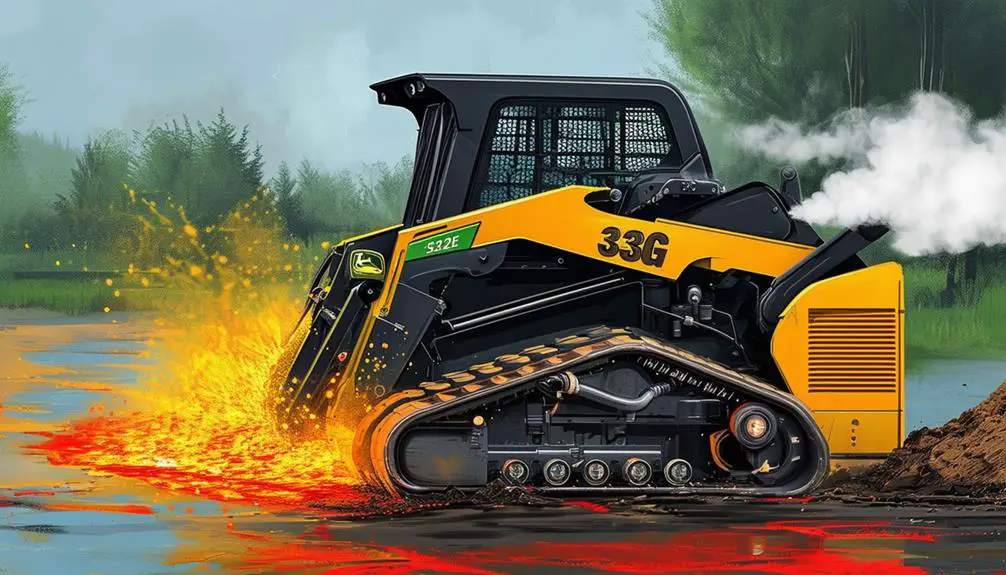
Identifying potential cooling system defects in your John Deere 333G is important for maintaining peak engine performance and preventing overheating issues. Here are some common cooling system problems you may encounter:
- Leaking Radiator: Check for any visible leaks or puddles of coolant under your machine.
- Faulty Thermostat: A malfunctioning thermostat can cause the engine to overheat or not reach best operating temperature.
- Clogged Radiator: Inspect the radiator for any debris or buildup that could be obstructing airflow.
- Water Pump Issues: Keep an eye out for signs of a failing water pump, such as coolant leaks or unusual noises coming from the pump area.
Regularly monitoring and addressing these cooling system issues can help you avoid costly repairs and downtime. Remember, a well-maintained cooling system is essential for the overall health and performance of your John Deere 333G.
Error Codes Displayed
Regularly check the display on your John Deere 333G for any error codes that may appear. These error codes are essential indicators of potential issues that need your attention. When you notice an error code displayed on your machine, don't overlook it. Take immediate action to investigate the problem and address it promptly to prevent any further damage or downtime.
Some common error codes that may show up on your John Deere 333G include codes related to engine malfunctions, hydraulic system problems, electrical issues, or sensor failures. Each error code provides valuable information about the specific area of concern, allowing you to diagnose the problem more efficiently.
To troubleshoot error codes effectively, refer to your John Deere 333G operator's manual for guidance on interpreting the codes and recommended steps for resolution. If you encounter recurring error codes or are unable to resolve issues on your own, seek assistance from a qualified technician to confirm the proper functioning of your equipment.
Frequently Asked Questions
How Can I Prevent Premature Wear on John Deere 333G Tracks?
To prevent premature wear on your John Deere 333G tracks, keep an eye on the tension and alignment regularly.
Make sure to clean the tracks after working in muddy or abrasive conditions.
Avoid excessive speeds and sharp turns that can strain the tracks.
Replace damaged or worn parts promptly to prevent further damage.
Following these steps will help you extend the lifespan of your tracks and keep your machine running smoothly.
What Are the Typical Signs of a Failing Hydraulic Pump on a 333g?
If your 333G's hydraulic pump is failing, you might notice decreased performance, unusual noises, or leaking hydraulic fluid. Keep an eye out for sluggish operation or jerky movements, as these could be signs of trouble.
Don't ignore any warning signs; address them promptly to prevent further damage. Regular maintenance and inspections can help catch potential issues early and keep your equipment running smoothly.
Are There Any Common Troubleshooting Tips for Electrical Issues?
When troubleshooting electrical issues on your John Deere 333G, start by checking the battery connections for any corrosion or loose wires.
Inspect the fuses to verify they're intact and not blown.
Test the electrical components one by one to identify the faulty part.
Don't forget to look for any exposed wires that could be causing a short circuit.
What Maintenance Practices Can Help Avoid Fuel System Troubles?
To steer clear of fuel system troubles, make sure you regularly change the fuel filters and use high-quality fuel. Think of it like watering a plant – give your machine clean fuel to thrive.
Additionally, keep an eye on any leaks or unusual smells around the fuel system. By staying proactive with these maintenance practices, you can prevent costly repairs down the road.
How Can Operators Address Error Codes Without Professional Help?
If you encounter error codes, first check the operator's manual for guidance.
Often, error codes can be resolved by following the recommended troubleshooting steps. Restarting the machine or performing a system reset may clear the error code.
If the issue persists, contact customer support for further assistance. Remember, staying calm and methodically addressing the error code can often resolve the problem without needing professional help.
Conclusion
Now that you're equipped with knowledge of the top 10 common problems with the John Deere 333G, you can tackle any issues head-on and keep your equipment running smoothly.
Remember, regular maintenance and prompt repairs are key to avoiding downtime and maximizing efficiency.
Keep those wheels turning and those tracks moving with confidence!